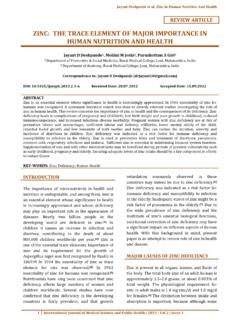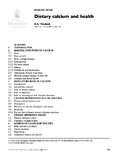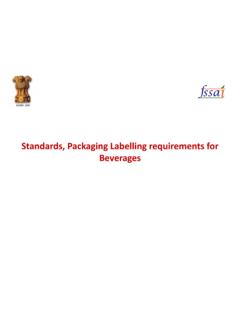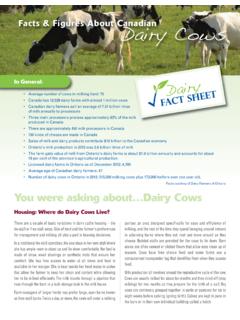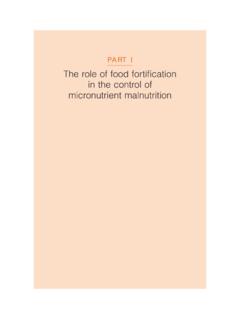Transcription of Japan Dairy Farming
1 1 Japan Dairy Farming Japan Dairy Council 2 Table of contents 1. About Dairy cows Breed of Dairy cows Lifecycle Structure of the body (Anatomy) Mechanism of ruminant and lactation 2. History of Dairy Farming and milk Origin of cattle domestication Origin of Japanese Dairy Farming Extension of milk and change of diet 3. Current situation of the Japanese Dairy Farming Japanese Dairy Farming with the advance of intensification and expansion Family run business Facilities on the farm Dairy farmers work Cost of milk production Environmental conservation and Dairy Farming Comparison with the world 4. Government measures Subsidy and production cost Planned production of raw milk 5.
2 Supply chain Dairy processing plants in Japan Distribution of drinking milk and other Dairy products 6. Current situation of consumption Types of milk Consumption of drinking milk and other Dairy products Trends of milk retail prices 7. Educational Dairy farms and their activities 3 41. About Dairy cows Breed of Dairy cows Holstein Holstein is a typical Dairy cow, and 99% of Dairy cows in Japan are Holsteins. They are originally from the Netherlands and Holstein region of Germany. They are big built and have large udder with high production yield of milk. They are the most common Dairy cows in the world.
3 They have mild temper and good tolerance with cold weather but not good with heat. They are not only black and white in colour but also brown and white. Jersey Jersey is the second popular breed in Japan after Holstein and originally from Jersey island in the English Channel. They are rather small and soft brown in colour. Their production yield is not as good as Holsteins', but milk fat content is higher. Brown Swiss Brown Swiss is the third popular breed in Japan and native to Switzerland. They are famouse Alpine breed with very rich milk which is suitable for natural cheese.
4 They are large in dark brown to silvery brown colour and mild in temper. 5 Lifecycle From conception to birth (artificial insemination and birth) Currently, at most Japanese Dairy farms artificial insemination (AI) is used for cows reproduction. However, there is no guarantee of conception. Life cannot be created just with human efforts and powers. After about 10 months in pregnancy, the waters break and delivery starts. More than 90% of calves come out with their head first. In case of a difficult delivery, a mother receives helps by human s pulling ropes tied on calf s legs in time with mother s pushing. Cow s birth ends in 30-40 minutes.
5 Mother removes amnion from her calf with her mouth and licks her calf s body with her long tongue. Calf tries to stand up within 30 minutes of being born. How soon they can get up and start walking, this is an important condition for the animal to determine whether they can survive or not. Nursing Calves are separated from their mothers as soon as they are born, and they are nursed in the barns dedicated to them. For the first week, they are given mothers colostrum. Just like human s, bovine colostrum contains plenty of protein and vitamins which are easy to digest as well as components to prevent them from catching illness (immunity).
6 Breeding Calves from the period of weaning (2months old) till the first mating (about 18 months old) are called breeding cows. Sometimes they are brought up grazing in the designated breeding field in order to gain healthy and strong body. Milking After cows give birth, they start producing milk as mothers do. Cows continue to produce milk for about 300 days. Milk production yield peaks at around the second and the third month after calving, and it gradually starts to get reduced. Dry After about 280-300 days of lactation, cows stop milk production and have a break for 2-3 months to prepare for the next calving.
7 They are called dry cows. 12-15 months cycle being repeated 3-4 times Average life of cows is about 12 years in their natural life, but Dairy cows are required to produce a lot of milk. After repeating 3-4 cycles of 12-15 months period each, they retire from their duty in about 5-6 years and are sold for meat. 6 Body structure of Dairy cattle (cow) Height Height is about 140-150cm from the ground to their shoulders when standing Length (horizontal length) Length is normally measured from the shoulders to the base of their tails. Cows are about 170cm long. Bust It is measured in the same way as human beings, and in the case of cows it is the circumference of their chest from the base of their front legs.
8 It is normally over 200cm. Weight Cows weigh about 600-700kg. Muzzle pattern Wrinkles on their noses are called muzzle pattern, and these are different from each individual just like human fingerprint. Tail It is used to keep flies and mosquitos away instead of hands and also keeps the balance of the body. Hoof A long, long time ago, the animal ancestral to both cattle and horses had 5 toes. During their evolution, horses had developed their middle toes and ended up with one hoof, and cows had developed their middle and ring toes which had evolved to two hooves, and they become family of even-toed ungulates (artiodactyla).
9 Cows hooves are known to grow about 3-10 cm per month. If they stay inside the barns too much and have not enough exercises, their nails grow too long which could cause them of developing hooves diseases. Therefore on farms, they have their hooves cut roughly twice a year. Tooth Ruminants like cattle have their characteristics of not having upper front teeth. length Height Bust 7 Spots Holsteins' spots (patterns on their body) are different on each cow just like human fingerprints and never change from their birth till their adulthood. Horns Their horns are often cut within 3-5 months of their birth in order to prevent them from getting into fights with other cattle and also to keep their careers safety.
10 Skeleton Cows ribs and bones are projected conveniently to support their big body and firmly developed. Their hind leg bones (metatarsal) are well developed to support their heavy udder. Dung and urine The output of dung is 20-40kg per day, and of urine is 6-12 litres per day. Rumination and mechanism of milk production Stomach Cows stomach occupies three quarters of their abdomen and divided into 4. The first and largest stomach (rumen) has a volume of 160 litres. What cows eat through their mouth such as grass first comes into this stomach. Here numbers of microorganisms decompose fibre and ferment food by propagating microorganisms.



